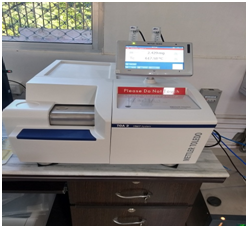The consumptions of energy have been exponentially increased in recent decades due toeconomical, industrial development, and population growth. With continuously increasingthe demand for energy, the utilization of renewable energy sources has also increased in a large scale. Biomass is known globally as a renewable and sustainable energy resource and it is considered as best substitute for depleting fossil fuels. This project deals with pyrolysis kinetics of Mesua Ferrea Seed Cover (MFSC) using thermogravimetric analysis (TGA). The temperature for the TGA study was maintained in the range of 30 to 1000°C with five different heating rates 10, 20, 30, 40 and 50 °C/min at atmospheric pressure. The TGA analysis reveals that decomposition intensity of MFSC was maximum0.39wt%/°C at 340°C and the maximum weight loss (93%) was observed at the heating rate of 10 °C/min. The TGA study reveals that the decomposition of biomass is characterized by three distinct stages. The activation energy of decomposition of biomasswas studied using three isoconversional methods such as, Starink, Kissinger and Akahira Sunose (KAS) and Flynn and Wall-Ozawa (FWO). The average value of activation energy is found to be 210.07 kJ/mol, 218.37 kJ/mol and 214.39 kJ/mol respectively for KAS, FWO and Starink method. It was observed that the value of activation energy increases from conversion (a)= 0.1 to 0.2. After a= 0.2 to a= 0.85, the activation energy is almost constant. The solid state reaction mechanism of the biomass was determined using Criado method. The study revealed that the degradation profile of MFSC has matched closely with the D2 mechanism for α ≤0.5, which is the two-dimensional diffusion (Valensi Model). However, for higher conversionα ≥ 0.5, the degradation profile of the biomass has closely matched with the master plotanalogous to the R3 mechanism which is third-order random nucleation. In the solid-statemechanism, the degradation process is started from any arbitrary points that act as growthcentres for the beginning of the degradation reaction. From the analyses, it is observed that,MFSC is a very good feedstock for bioenergy potential.



 '
'